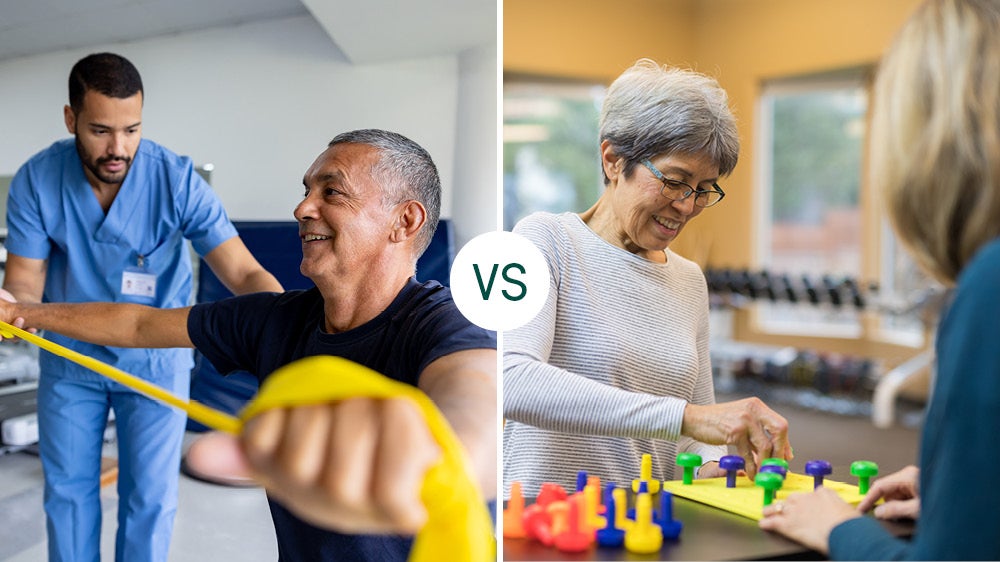What is the difference between a Physical Therapist and an Occupational Therapist?
March 25, 2024Categories: Therapy and Rehabilitation
By Kristin Hightree, Occupational Therapist and Lynn M. Kious, Physical Therapist, MercyOne Siouxland Medical Center
Injuries and illnesses requiring therapy and rehabilitation can be extremely painful and frustrating. You may feel your life is completely disrupted as you recover and try to return to your daily routine. Fortunately, there are two types of health care professionals trained to help you -- Physical Therapists (PTs) and Occupational Therapists (OTs).
Differences and similarities between a PT and an OT
Chances are you are familiar with these titles, but you are not exactly sure of the difference between an OT and a PT.
PTs:
- Spend time evaluating and educating patients on why we hurt. A cognitive-based approach to treatment called Pain Neuroscience Education may be used.
- Treat any pain within the body, as well as any joint, mobility, balance or strength problem.
- Teach you how to walk after an injury.
- Help you recover from surgery or problems in the body, such as headaches, neck pain, joint problems, jaw, back issues, hip pain, knee pain, sprained ankles, foot pain and toe problems.
- Help retrain the bladder.
- Treat dizziness.
- Retrain eye muscles.
- Restore proper joint mechanics and strength and often rely on correct posture.
- Work with patients of all ages.
OTs:
- Focus on using occupations or purposeful functional activities to return a patient to function independently at home, community and work environments.
- Specialize in hand therapy to regain hand strength and coordination following an injury.
- Use modalities such as ultrasound or electrical stimulation to decrease pain and increase mobility.
- Work through difficulties a person has with overall arm motion and controlled hand and finger motion related to normal daily activities such as eating, bathing, dressing, grooming, cooking and cleaning.
- Address cognitive and emotional health challenges, such as attention, visual motor and perceptual skills to complete activities.
- Work with children in school and in outpatient settings to increase fine motor skills, vision and sensory processing skills.
- Work with patients of all ages.
Let’s look at the work OTs and PTs would do with you if you were recovering from a stroke that weakened the left side of your body.
A PT helps you build strength and mobility
A PT may focus first on helping you learn how to get out of bed and stand safely, as well as helping teach you how to move around the room, whether that means walking or using a wheelchair. The PT will also focus on making your leg move better.
An OT helps you perform daily tasks
An OT working in an inpatient rehabilitation unit would focus on building skills to improve your independence with feeding, bathing, dressing, toileting, bathroom transfers and necessary homemaking activities to return home safely.
OTs focus on:
- Retraining you on techniques to dress yourself with only one hand.
- Educating you on adaptive equipment to assist with self-care tasks.
- Ensuring safety at home with equipment such as a shower chair to prevent falls when bathing.
- Strengthening the left side with emphasis on the left arm to increase shoulder, elbow and hand strength and function.
- Increasing balance and coordination to perform activities that are most important to your everyday life, such as getting dressed.
- Improving your fine motor skills.
- Helping you cope with cognitive, physical and emotional health challenges.
- Addressing your health management routine for your overall well-being.
All therapists work to teach an individual how to function. PTs and OTs can use similar treatments, for example, how to put on a brace, how to move from the bed or chair, and how to balance. PTs and OTs can also treat similar orthopedic conditions of the arm, wrist and hand. Both PTs and OTs can teach you how to use a wheelchair.
Obviously, there is overlap between these two professions. Both a PT and an OT use a comprehensive approach to improve your strength, balance, and coordination and help you live independently. Through therapeutic exercises and education, OTs and PTs work with you to rehabilitate your body and mind and teach you ways to cope with everyday life. If needed, your health care provider may prescribe that you go to both a PT and an OT to meet all your therapy needs.
PTs and OTs are part of your support team
Recovering from an injury or illness is never convenient or comfortable, but you can rely on your PT and/or OT to assist you in your return to your daily life with increased strength, mobility and confidence. In that way, they are key members of your recovery support team.
MercyOne has multiple physical therapy locations to help you rehabilitate from an illness, injury or surgery and to get you back to your best life.

